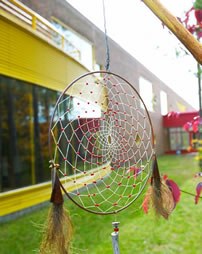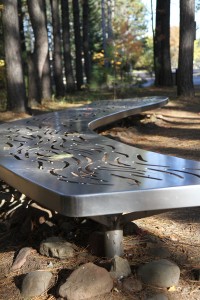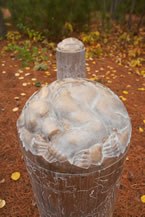 Fond du Lac Tribal and Community College is located in Cloquet, Minnesota, just off Interstate 35. The campus is situated in a beautiful setting, a 38-acre former tree farm of 60-foot tall majestic red pines. The college sits on top of a bluff overlooking Cloquet, a community of approximately 13,000 people. The Fond du Lac Reservation Business Committee offices are approximately five miles away from the college.
Fond du Lac Tribal and Community College is located in Cloquet, Minnesota, just off Interstate 35. The campus is situated in a beautiful setting, a 38-acre former tree farm of 60-foot tall majestic red pines. The college sits on top of a bluff overlooking Cloquet, a community of approximately 13,000 people. The Fond du Lac Reservation Business Committee offices are approximately five miles away from the college.
The Fond du Lac Tribal and Community College campus is the product of extensive consultation among tribal and civic leaders, business people, educators, and students. This group defined their needs and, with the help of a skilled architect, created a campus reflecting the integrated cultures of the Northeastern Minnesota area.
The symbolic concepts integrated into the design include The sacred circle and the wheel represented in the campus ring road, which has its northerly slopes planted to represent the bear paw. Together, the bear paw and the circle represent strength and protection.
The four directions and the cross are formed by the 90-foot-wide clearing in the middle of the campus. The 70-foot-wide building is centered in the clearing. The four arms of the building represent the four directions, an American Indian symbol representing greater harmony in life.
 The four colors of the Fond du Lac Reservation are red, black, white, and yellow. These colors are used on the four exterior metal walls of the building and are also representative of the four directions: north, south, east and west. The theme of diversity is represented in the many different construction materials visible throughout the academic building, and in the varying sizes and shapes of the windows in the building.
The four colors of the Fond du Lac Reservation are red, black, white, and yellow. These colors are used on the four exterior metal walls of the building and are also representative of the four directions: north, south, east and west. The theme of diversity is represented in the many different construction materials visible throughout the academic building, and in the varying sizes and shapes of the windows in the building.
From above, the Thunderbird dominates the shape of the academic building. Extensive use of large windows provides earth and sky views of the outdoor environment, and represent the importance of having a vision for the future. The building design combines straight lines and circular elements to depict the college’s role of bringing people from different backgrounds together in a safe, respectful place for everyone.
The circular amphitheater is topped with a blue dome to represent the sky. Large floor-to-ceiling windows separate the two halves, indoors and outdoors, of the amphitheater circle. Floor tiles and carpeting in the amphitheater area are green and brown to represent the earth.
Several works of art are featured in prominent locations on campus. “Ojibway Stream,” composed of stainless steel and river rocks by artist Truman Lowe, is a sculpture about streams and the importance of water to life. Located among the pine trees along the walkway to the main entrance of the college, the sculpture is in the form of a bench 25 feet in length. Patterns cut into the stainless steel resemble the river current surface movements of water. A rocky stream bed is visible below. The mirror-like surface of the bench reflects the trees and sky in summer and appears to glow against the snow cover in winter.
 “Chiringa,” a totem sculpture in bronze by George Morrison, is perched upon a large igneous rock located in a clearing in the woods. For this sculpture, Morrison was inspired by the many forms, variations, and meanings of totems created by peoples and civilizations since the dawn of time. The “Chiringa” form, in particular, has been inspired by Central Australian Aborigines. Morrison’s totemic piece is not specific in meaning, nor does it tell the story of a clan by objective marks and imagery. This sculpture is a contemporary and abstract version of many kinds of totems.
“Chiringa,” a totem sculpture in bronze by George Morrison, is perched upon a large igneous rock located in a clearing in the woods. For this sculpture, Morrison was inspired by the many forms, variations, and meanings of totems created by peoples and civilizations since the dawn of time. The “Chiringa” form, in particular, has been inspired by Central Australian Aborigines. Morrison’s totemic piece is not specific in meaning, nor does it tell the story of a clan by objective marks and imagery. This sculpture is a contemporary and abstract version of many kinds of totems.
“Jack’s Path” is the permanent memorial on campus that honors the late Lester Jack Briggs, founding president of the college. The memorial remembers Briggs and his leadership during the formative years of the college, his accomplishments, and the long-reaching effect he had touching people’s lives. Briggs served as president of Fond du Lac Tribal and Community College from its inception in 1987 until his passing in December 2001.
Created by artist Sterling Rathsack, faculty member and a sculptor and painter from Superior, Wisconsin, the memorial includes four 600-pound bronze sculptures. Nestled among the trees on the north side of the campus, the site is a quietly stated marker of Briggs’ personal background and professional service. The memorial provides a location for reflection, remembrance, and inspiration.
The development of the iconography on the sculptures was created from the ideas generated by Briggs’ family, college students, college employees and friends as they related their experiences and stories about Jack. One piece is highlighted by a sleeping bear, a symbol of the soul. One features a turtle image, which is representative of the creation stories of Ojibwe culture. Another indicates the four compass directions, and the fourth sculpture contains an inscription about Briggs and serves as a basin for offerings.
The four sculptures are made from recycled materials. Rathsack chose recycled materials because of Briggs’ philosophy to help people succeed, especially people in need of a second chance at something. Many people explained stories about how Jack promoted getting the full potential out of things, whether it was a person or materials. The artist felt it was important to use recycled materials in the project, to emphasize giving something a second chance and a new life.
Take a moment to watch this short video featuring artist Sterling Rathsack as he describes his inspiration and process behind the creation of “Jack’s Path.”
The larger-than-life-size breastplate located on the amphitheater wall was created by Cynthia Holmes, a faculty member in the Art Department at Fond du Lac Tribal and Community College. This piece, “Niigahnii Gwuhne’yaush” (Leading Feather), honors Lester Jack Briggs, the first President of Fond du Lac Tribal and Community College. Because of Jack’s heart and spirit, he was larger than life, and Holmes wanted to ensure the campus had adequate representation of Briggs for the future. The materials also reflect the bridge between communities and cultures that come to learn together at the college. The hairpipes are made of clay, representative of the Native American culture. The beads are fishing net floats, representative of the non-native settlers to the area who fished the waters of Lake Superior.